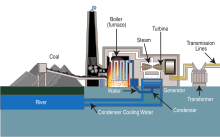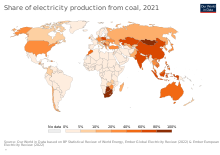
Back محطة طاقة فحمية Arabic داش کؤمور الکتریک مرکزی AZB Uhelná elektrárna Czech Kohlekraftwerk German Central eléctrica de carbón Spanish نیروگاه زغال سنگ سوز Persian Pembangkit listrik tenaga batu bara ID Centrale a carbone Italian 石炭火力発電所 Japanese Kolencentrale Dutch




A coal-fired power station or coal power plant is a thermal power station which burns coal to generate electricity. Worldwide there are about 2,500 coal-fired power stations,[1] on average capable of generating a gigawatt each.[2][a] They generate about a third of the world's electricity,[3] but cause many illnesses and the most early deaths per unit of energy produced,[4] mainly from air pollution.[5][6] World installed capacity doubled from 2000 to 2023 and increased 2% in 2023.[7]
A coal-fired power station is a type of fossil fuel power station. The coal is usually pulverized and then burned in a pulverized coal-fired boiler. The furnace heat converts boiler water to steam, which is then used to spin turbines that turn generators. Thus chemical energy stored in coal is converted successively into thermal energy, mechanical energy and, finally, electrical energy.
Coal-fired power stations emit about 12 billion tonnes of carbon dioxide each year,[2] about one fifth of world greenhouse gas emissions,[8] so are the single largest cause of climate change.[9] More than half of all the coal-fired electricity in the world is generated in China.[10] In 2020 the total number of plants started falling[11][12] as they are being retired in Europe[13] and America[14] although still being built in Asia, almost all in China.[15] Some remain profitable because costs to other people due to the health and environmental impact of the coal industry are not priced into the cost of generation,[16][17] but there is the risk newer plants may become stranded assets.[18] The UN Secretary General has said that OECD countries should stop generating electricity from coal by 2030, and the rest of the world by 2040.[19]
- ^ "Coal burning capacity climbs worldwide despite pledges to reduce use". PBS News. 6 April 2023. Retrieved 16 November 2024.
- ^ a b "What would it cost to kill coal?". The Economist. ISSN 0013-0613. Retrieved 16 November 2024.
- ^ Birol, Fatih; Malpass, David (8 October 2021). "It's critical to tackle coal emissions – Analysis". International Energy Agency. Retrieved 9 October 2021.
- ^ "How safe is nuclear energy?". The Economist. ISSN 0013-0613. Retrieved 26 December 2022.
- ^ Cite error: The named reference
:4was invoked but never defined (see the help page). - ^ "Killed by coal: Air pollution deaths in Jakarta 'may double' by 2030". The Jakarta Post. Retrieved 8 April 2022.
- ^ Boom and Bust Coal 2024 (PDF) (Report). San Francisco, California: Global Energy Monitor. April 2024. p. 7, 21. Retrieved 11 April 2024.
2% annual increase in the global operating coal fleet, which currently stands at 2,130 GW […] Figure 16: Global coal power capacity continues steady growth despite Paris Agreement, with a 2% uptick in 2023
- ^ "Country Inventory - Climate TRACE". climatetrace.org. Retrieved 16 November 2024.
- ^ "It's critical to tackle coal emissions – Analysis". IEA. 8 October 2021. Retrieved 9 October 2021.
- ^ "China generated over half world's coal-fired power in 2020: study". Reuters. 28 March 2021. Retrieved 14 September 2021.
China generated 53% of the world's total coal-fired power in 2020, nine percentage points more that five years earlier
- ^ Morton, Adam (3 August 2020). "More coal power generation closed than opened around the world this year, research finds". The Guardian. ISSN 0261-3077. Retrieved 4 August 2020.
- ^ "The dirtiest fossil fuel is on the back foot". The Economist. 3 December 2020. ISSN 0013-0613. Retrieved 12 December 2020.
- ^ Piven, Ben. "EU power sector emissions drop as coal collapses across Europe". Al Jazeera. Retrieved 21 March 2020.
- ^ Roberts, David (14 March 2020). "4 astonishing signs of coal's declining economic viability". Vox. Retrieved 21 March 2020.
- ^ "China pledges to stop building new coal energy plants abroad". BBC News. 22 September 2021. Retrieved 22 September 2021.
- ^ Borenstein, Severin; Bushnell, James B. (1 November 2022). "Do Two Electricity Pricing Wrongs Make a Right? Cost Recovery, Externalities, and Efficiency" (PDF). American Economic Journal: Economic Policy. 14 (4): 80–110. doi:10.1257/pol.20190758. Retrieved 11 November 2022.
- ^ Davis, Lucas (21 September 2020). "Time to Vote Out Coal". Energy Institute Blog. Retrieved 27 September 2020.
- ^ Harrabin, Roger (12 March 2020). "Coal power developers 'risk wasting billions'". BBC News.
- ^ "The dirtiest fossil fuel is on the back foot". The Economist. 3 December 2020. ISSN 0013-0613.
Cite error: There are <ref group=lower-alpha> tags or {{efn}} templates on this page, but the references will not show without a {{reflist|group=lower-alpha}} template or {{notelist}} template (see the help page).